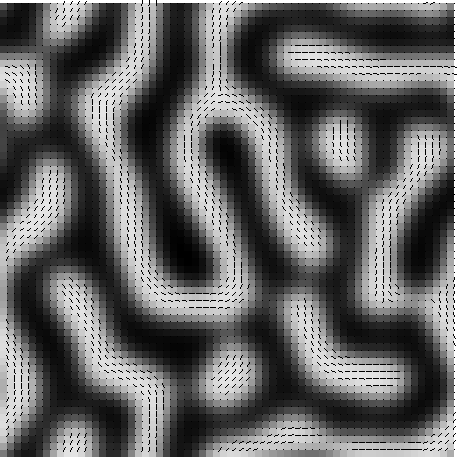
Materials consisting of liquid crystal droplets dispersed in a polymer matrix are being used in new kinds of flat panel displays and other optical devices. Understanding the processes by which the droplets form in these materials is crucial because the behavior of the devices depends on the size, shape, and distribution of the droplets. The droplets can be formed in a number of ways, all of which combine the processes of phase separation and orientational ordering. Typically, the liquid crystal and polymer molecules are mixed together and conditions are changed (eg, temperature is decreased, or the degree of polymerization is increased) to make the two materials immiscible. At some point in the process the liquid crystal may undergo a phase transition from the isotropic state, in which the molecules are unordered, to the nematic state, in which the molecules tend to align with their neighbors. The coupling between the processes of phase separation and ordering makes this problem both theoretically and computationally rich.
The NIST Center for Theoretical and Computational Materials Science (CTCMS) has joined forces with the NSF Center for Advanced Liquid Crystalline Optical Materials (ALCOM) to pursue theory and modeling of materials used in optical displays. As part of this effort Steve Langer (ACMD) and Sharon Glotzer (CTCMS) have been simulating two dimensional mixtures of polymer and liquid crystal in which phase separation (caused by a temperature drop) creates regions of liquid crystal whose density is above the critical ordering density. The immediate goal is to determine the effect of the liquid crystal ordering on the underlying phase separation process. The equations of motion for the system were derived by Liu and Fredrickson for a blend of two polymers and have been specialized to the case in which one of the polymers is short and rigid like a liquid crystal molecule. The resulting three equations (one for the density and two for the two independent components of the liquid crystal orientational order parameter) are fourth order in space and first order in time, with no linear terms on the right hand side. Packaged differential equation solvers have been ineffective. So far the best results have been obtained with a semi-implicit Crank-Nicholson algorithm using sparse matrix methods. Due to the complexity of the equations, it was necessary to use a symbolic algebra program to generate the C code to compute the Jacobian. Improvements to the algorithm and adaptations for parallel computers are in progress. When the algorithm is in place, the various regions of the phase diagram will be studied to determine the dependence of quantities such as droplet shape, domain size, and liquid crystal defect density on parameters such as thermal quench depth, molecular interaction strength, and polymer length. An intermediate stage in a typical run is shown below.

Caption: Pattern formation during phase separation of polymer (dark) and liquid crystal (light). The short lines show the local liquid crystal orientation in the ordered regions.